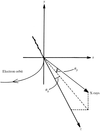issue contents
September 2000 issue

Cover illustration: Diffraction images of two samples from the same breast, collected during a study of breast cancer diagnosis using scattered X-rays, see Lewis, Rogers, Hall, Towns-Andrews, Slawson, Evans, Pinder, Ellis, Boggis, Hufton and Dance, pages 348-352. Left: apparently normal breast tissue. Right: tumour tissue.
facility information
lead articles
Synchrotron radiation circular-dichroism spectroscopy as a tool for investigating protein structures
Synchrotron radiation circular dichroism (SRCD) spectroscopy is a technique that is proving to be useful for examining secondary structures and folding motifs of proteins. New developments in instrumentation and in bioinformatics mean that SRCD has considerable potential for the future in the fields of structural molecular biology and structural genomics.
research papers
The newly commissioned Canadian spherical-grating-monochromator beamline is described. The photon energy range for this beamline, using the medium-energy grating, is 240–700 eV. A maximum resolving power of ∼10000 is achieved at a photon energy of ∼400 eV.
Synchrotron beam measurements were performed with a single-photon-counting pixel detector to investigate the influence of threshold settings on charge sharing.
Because the generation of X-rays in a synchrotron radiation source (SRS) is highly structured in time, the rate performance of a counting X-ray detector may be determined as much by the beam structure as by the detector dead time. Using analytical and Monte Carlo models, equations and graphs are derived which permit the evaluation of the rate performance of a counting detector used in conjunction with the common SRS beam modes.
A quantitative study of primary radiation damage of protein crystals by an intense monochromatic X-ray beam from a third-generation synchrotron radiation source reveals an upper limit of X-ray dose.
Ion-implantation-induced strain profiles were determined both for AIIIBV compounds implanted with heavy ions and for silicon implanted with light ions. Based on these profiles, a number of diffraction phenomena were explained.
Noticeable enhancement of the spin-dependent Compton scattering intensity in right-angle scattering has been achieved by using high-energy X-rays having elliptical polarization.
A wavelength-dispersive double flat-crystal analyzer for inelastic X-ray scattering is described. Experimental characterization of this new X-ray optic and comparison with a spherical-focusing backscattering analyzer are presented.
A fixed-exit monochromator has been constructed for computed tomography studies at the Medical Beamline of the European Synchrotron Radiation Facility. The performance of the monochromator is studied with respect to the beam intensity and energy distributions. Examples from phantom studies and in vivo animal experiments are shown to illustrate the spatial resolution and contrast of the reconstructed images.
Differences in the small-angle X-ray scattering patterns of human breast tissue have been shown to correlate with pathology.


 journal menu
journal menu


































